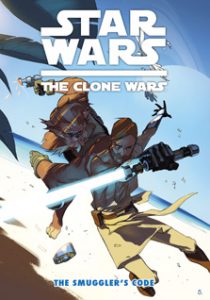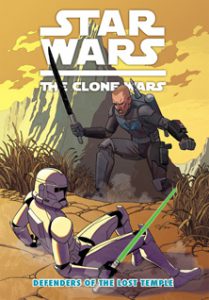“The Clone Wars” digests, like their parent show, came to a premature conclusion in 2013 with Disney’s purchase and rebooting of the franchise. As with the TV show, the digests were starting to be more consistently good when they ended. No. 9, “The Sith Hunters,” which I reviewed in a previous post, is the best and most essential issue, as it fills in Darth Maul’s story between “The Phantom Menace” and “The Clone Wars.”
The series then concludes with writer Justin Aclin’s only two “Star Wars” efforts. “Defenders of the Lost Temple” (March 2013) – set between Seasons 4 and 5 – feels very much like a TV episode. The idea of Jedi and clones searching an abandoned temple for a Sith artifact is standard stuff, but extra intensity comes from Pre Viszla and Death Watch entering the fray. I also like that this is not a top-level Republic group, which makes sense, as the elite men and women are on more crucial missions.
Rennax, a Jedi Padawan who doesn’t want to fight, and Glitch, a clone trooper who wants to tap into the Force more than he wants to fight, are not wholly original characters. But I love the happy endings Aclin provides for them: With her master’s and the Order’s blessing, Rennax leaves the Jedi to reunite with her family and start a life outside of warfare. And Glitch – thought to be dead, and therefore left behind – can start a life on Draay 2, where the temple is located. (It’s unclear if there is any civilization on the moon, but there is abundant flora and fauna, so we at least know Glitch can live off the land.)

The series finale, “The Smuggler’s Code” (June 2013) – set during Season 4 — reminds me of “Underworld: The Yavin Vassilika” thanks to the pencils and inks of Eduardo Ferrara. This is the kind of crazy-but-fun art that I wouldn’t want to see in every “Star Wars” comic, but I like it now and then. It pairs nicely with Aclin’s story about a single-minded Obi-Wan wanting to bring the Shistavanen criminal T’Mott Zoat to justice because 20 years ago, he killed someone who was under Obi-Wan’s protection.
I thought for sure this was a reference to the “Jedi Apprentice” young-adult books, but Wookieepedia tells me it is not; Zoat only appears in this novella, as does the smuggler Rook Pryce, with whom Obi-Wan begrudgingly teams up on the colorful beach-resort planet Wielu. Pryce – who always takes the best deal, even if it means breaking a contract (that’s his version of the titular code) – is somewhat in the vein of Hondo Ohnaka, and he would’ve been worth exploring further.
Thematically, this issue falls into the “Obi-Wan realizes he needs Anakin’s and Ahsoka’s help” subgenre. There are also several stories where Anakin realizes he needs Obi-Wan’s and Ahsoka’s help, but interestingly, not as many where Ahsoka is determined to go solo (at least not until she gives up on the Jedi Order at the end of Season 5, with very good reason). So a strong case could be made that Ahsoka is the most mature Jedi out of the trio.

Largely an experimental “throw it at the wall and see what sticks” series, “The Clone Wars” digests deliver more good than bad, and like the TV show, they leave a reader wanting more – partly because of all the one-and-done characters (Aclin’s entries being prime examples) and partly because the series allows us to spend more time with the heroes and villains of the Clone Wars.
Here are my rankings of the digests:
1. “The Sith Hunters” (9)
2. “Strange Allies” (7)
3. “Deadly Hands of Shon-Ju” (5)
4. “Crash Course” (2)
5. “Defenders of the Lost Temple” (10)
6. “The Smuggler’s Code” (11)
7. “Shipyards of Doom” (1)
8. “The Enemy Within” (8)
9. “The Colossus of Destiny” (4)
10. “The Wind Raiders of Taloraan” (3)
11. “The Starcrusher Trap” (6)

